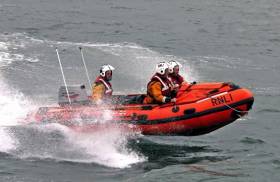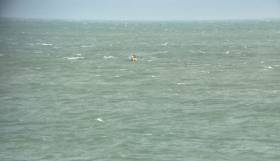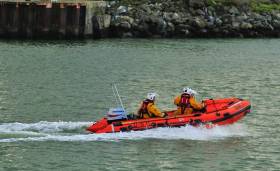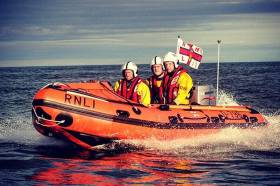Displaying items by tag: RNLI
Fethard Lifeboat Assists Man After Pleasure Craft Breakdown
#RNLI - Fethard RNLI launched yesterday afternoon (Thursday 29 September) to assist a man whose pleasure craft broke down off the Wexford coast.
The volunteer lifeboat crew were requested to launch their inshore lifeboat at 4.07pm following a report that a 21ft pleasure boat, with one onboard, had sustained engine failure in an area known locally as the Horseshoe.
Helmed by Eoin Bird and with crew members Patrick Byrne and Damian Murphy onboard, the lifeboat made its way to the scene 1.5 nautical miles from Fethard Harbour. Weather conditions at the time were described as good with a Force 5 westerly but sheltered wind blowing.
Once on scene, the lifeboat crew observed that the boat had washed up on the sand due to the tide.
The crew beached their D-class lifeboat before working to set up a towline with the casualty vessel. Once this was set up, the lifeboat proceeded to tow the pleasure boat back to Fethard Harbour, where it arrived at 5.10pm.
Speaking following the callout, Fethard RNLI deputy launching authority Hugh Burke said: “The area in which the man got into difficulty today is one where our lifeboat crew has to train regularly due to the sandbanks and sandbars which change regularly with each gale of wind.
“We would always encourage anyone planning a boat trip to always respect the water – make sure you wear a life jacket and carry a means of communication should you get into trouble and need to make contact.”
Ballycotton Lifeboat Launches To Stranded Dolphin
#RNLI - Ballycotton RNLI launched around 1pm yesterday afternoon (Thursday 29 September) to aid a dolphin stranded in shallow water on Silver Strand beach near the East Cork village.
A member of the public who was on scene had tried to assist the dolphin back to sea, but when they were unable to do so they alerted the Ballycotton lifeboat.
Ballycotton’s inshore lifeboat and its volunteer crew were quickly on scene, with the all-weather lifeboat on standby due to the offshore breeze and calm weather conditions.
Upon arrival, coxswain Eolan Walsh entered the water, guided the marine mammal into deeper water and shepherded it back out to sea.
Speaking after the callout, Walsh said: “Similar to a previous launch last summer, this dolphin appeared to be quite young and may have been separated from its pod.
“We would like to commend the member of the public who assisted the dolphin initially. We were happy to help and bring the dolphin into deeper waters.”
Howth Rescue Teams Launch To Lone Kayaker
#Rescue - Howth’s coastguard and lifeboat teams launched to the rescue of a lone kayaker off the North Dublin headland yesterday morning (Wednesday 28 September).
After a concerned onlooker called 999 when spotting that the kayaker was on the water with no life jacket, Howth Coast Guard and Howth RNLI’s inshore lifeboat were both tasked to the scene near Ireland’s Eye.
In the meantime the kayaker had proceeded around the back of the island and out of visibility from the caller on land. While the kayaker didn’t appear in difficulty, there were concerns for their safety.
A coastguard mobile unit proceeded to the end of the pier while the lifeboat launched on service to the far side of Ireland’s Eye, where the crew located a female on an open-deck kayak struggling in the water. She was brought back ashore by the lifeboat without incident.
“If she fell in the water, she had no means of staying afloat as she had no life jacket and only had a phone to call for help, there can be very limited if any phone signal once you go on the water,” according to an Irish Coast Guard spokesperson.
“The kayaker hadn’t checked the weather, which was unsuitable for the craft she was in. The lessons learnt are you need to have an emergency plan if going on the water – VHF radio, flares, whistle, weather information.
“Equally if not more important, you need a life jacket, no excuse.”
The rescue came just hours after Larne RNLI launched to assist two kayakers in difficulty off the Co Antrim coast, as previously reported on Afloat.ie.
Larne RNLI Rescue Two Kayakers
Larne RNLI has rescued two kayakers who got into difficulty off the County Antrim coast yesterday evening (Tuesday 27 September).
The volunteer lifeboat crew responded to a launch request from Belfast Coastguard at approximately 6.30pm following reports of two kayakers in difficulty at Ballygally Head.
The initial alarm was raised by a member of the public reporting two kayakers in trouble with one kayaker in the water.
Weather conditions were described as blowing a Force 3-4 wind with a slight swell and reduced visibility due to darkness falling.
Both Larne RNLI’s all-weather and inshore lifeboats launched at 6.42pm and the crews were quickly on scene. The casualties were located and recovered into the inshore lifeboat and were medically assessed by the crew.
Larne’s inshore lifeboat crew transferred the kayakers safely back to shore at Ballygally and into the care of the Coastguard while the all-weather lifeboat returned the kayaks to shore.
Speaking following the call out, Larne RNLI Coxswain Frank Healy said: 'The kayakers were located quickly this evening and returned safely to shore and we like to wish them both well following their ordeal.
‘Our volunteer crew train all year round to ensure when the pager sounds they are competent to complete any rescue and this training quickly swung into action this evening. We would like to commend the member of the public who contacted the Coastguard and we would urge anyone who sees someone in distress around the coastline to never hesitate in dialling 999 and asking for the Coastguard.’
Clifden Lifeboat Assists In Medevac From Inishturk
#RNLI - An island medical evacuation was carried out yesterday (Monday 26 September) by the volunteer crew of Clifden RNLI on the Mersey class all-weather lifeboat Fisherman's Friend.
In calm seagoing conditions, the lifeboat was launched at 1.15pm to attend to a man who had experienced a fall at the north end of Inishturk off the Mayo coast.
On arrival at the pier in Inishturk, the casualty was taken aboard the lifeboat and transferred to Cleggan pier, where he was moved to a waiting ambulance with the assistance of the Cleggan Coast Guard Unit.
Speaking following the callout, Clifden RNLI coxswain Alan Pryce said: “We were glad to be able to transfer this man safely to shore and we wish him a speedy recovery.
“The capability of the all-weather lifeboat in carrying out long-range shouts such as this one is reassuring, both for us as volunteers and all those who live on and visit our offshore islands.”
Stricken Trawler Rescued By Courtmacsherry RNLI
The Courtmacsherry RNLI All Weather Lifeboat has arrived in Union Hall with the stricken 60–ft fishing boat that had got into difficulties some seven hours earlier. The crew reported via a Mayday call at 5.46 pm last evening that they were sinking some 20 miles off the Seven Heads in West Cork. In a difficult tow, in very poor conditions, the lifeboat moored the casuality at the pierhead and will soon proceed back on the two hour trip to base in Courtmacsherry where they will refuel and get ready for whenever the next callout will happen.
The Navy vessel LE Niamh stood by as the powerful Trent Class Lifeboat towed the trawler, while the Lifeboat crew at the same time used its mobile pump to keep the water ingress under control.
"We are all pleased that this evenings rescue was carried out efficiently by Coxswain Sean O'Farrell and his voluntary crew of five including local farmer Colin Bateman who manned the mobile pump as he boarded the Fishing Vessel" said Courtmacsherry Lifeboat Voluntary Operations Manager Brian O'Dwyer who also praised the fast response of the crew this evening, when every minute gained was precious.
The crew on this evenings callout were Coxswain Sean O'Farrell and voluntary crew members Pat Lawton (Mechanic), Colin Bateman, Ciaran Hurley, Dara Gannon and Conor Dullea.
Wicklow Lifeboat Assists Drifting Jet Skier
#RNLI - Wicklow RNLI's inshore lifeboat launched shortly after 5pm yesterday evening (Sunday 25 September) to assist a person on a broken-down personal water craft.
The man had set off from Wicklow Harbour and was about a mile offshore when the engine cut out, leaving him adrift and unable to get ashore.
The lifeboat was alongside the casualty within minutes of launching and the crew carried out a quick assessment before towing the craft back into Wicklow Harbour and landing the man safely ashore.
Howth RNLI to Name New Lifeboat 'Aideen Cresswell' In Memory of Local Donor with Love of the Sea
Members of Howth RNLI lifeboat will gather at the lifeboat station this Sunday (2 October 2016) to name their new inshore lifeboat Aideen Cresswell in memory of the incredible woman who funded it. Aideen Cresswell (nee Stokes) was born in London in 1921 to Irish parents but came to live in The Baily, Howth. At a young age she met her husband John Cresswell at an RNLI ball and they spent their honeymoon on board a yacht sailing from Dublin to Waterford.
Mrs Cresswell passed away in 2011after a short illness but she will be remembered during the naming ceremony and service of dedication for Howth RNLI’s new inshore lifeboat. She will be represented at the ceremony by her two nephews, Andrew O’Hanlon and Seymour Cresswell, who will hand the new lifeboat into the care of the RNLI and officially name the inshore lifeboat Aideen Cresswell after their aunt.

Following the ceremony the new lifeboat will launch in Howth Harbour to the accompaniment of a lone piper. The well-known Dublin lifeboat station was established before 1825 and taken over by the RNLI in 1862. During its tenure Howth’s volunteer lifeboat crew have been awarded eleven medals for Gallantry: seven silver and four bronze. The station also operates an all-weather lifeboat.
The inshore lifeboat remains the workhorse of the RNLI as it has for nearly 50 years. The inflatable rescue craft is highly manoeuvrable and specifically suited to surf, shallow water and confined locations – often working close to cliffs, among rocks or even in caves.
Equipment includes VHF radio, night-vision equipment, and first-aid kit including oxygen. It has a maximum speed of 25 knots and can carry three crew members and five survivors.
Colm Newport, Howth RNLI Lifeboat Operations Manager said: ‘We are grateful to our donor for her generous gift which has funded our new lifeboat and we look forward to welcoming representatives of her family to Howth to share this day with us. Our volunteer lifeboat crew will be proud custodians of this search and rescue vessel for many years to come.’
‘We hope people will come down and join us for the ceremony and see the wonderful legacy Mrs Aideen Cresswell has left the people of Howth.’
Larne Lifeboat Station To Open Its Doors For Macmillan Coffee Morning
#RNLI - Larne RNLI's volunteer crew are throwing open the doors of their lifeboat station this coming Friday 30 September as they host a coffee morning to raise funds for Macmillan, the cancer support charity.
Doors open at 10am at 11 Olderfleet Road and the crew are already planning a 'bake off' to entice the public along and to dig deep for the charity.
The main organiser of the fundraiser is Larne RNLI lifeboat mechanic Derek Rea, who lost his uncle to cancer when he was younger and has had some close friends battle the illness.
It is a cause that is close to the heart of the entire station. Second coxswain Norman Surplus recently had his own battle with the disease and raised funds for cancer charities when he flew his gyrocopter round the world last year.
Commenting on the fundraising event, Rea said: "This will be a fundraiser with a difference for us here. As a charity we are thankful to the people of Larne for supporting the lifeboat but we also want to help others and raise funds for this worthy cause.
"There is hardly a person whose life has not been touched by cancer, either through battling it themselves or seeing someone they care about suffering with it. Support for cancer sufferers and research into treatment is ongoing and the Macmillan coffee morning is a great way to raise awareness and funds for this work."
Learn more about the Macmillan coffee morning fundraisers HERE.
Dramatic Rescue Of NI Trawler In Irish Sea Off Isle Of Man
#RNLI - Two British naval war ships, three helicopters and a fishing vessel joined Peel RNLI in the dramatic rescue of a trawler between Northern Ireland and the Isle of Man in the early hours of Wednesday morning (21 September).
The 20m converted fishing vessel from Kilkeel in Co Down was on passage in the Irish Sea from Glasgow to Conwy in Wales when it started taking water through the stern tube and was in danger of sinking some 11 miles west of the Isle of Man.
Peel's all-weather lifeboat Ruby Clery, under the command of coxswain Paul Cain, launched shortly after the volunteer crew were alerted at 1.30am.
Northern Irish fishing vessel Stephanie M gave shelter to the casualty until the lifeboat crew were able to put a pump on board to evacuate the water.
The vessel, with three adults and one child on board, was soon stabilised and helicopters and other vessels stood down. The trawler was then taken in tow by the lifeboat bound for Peel.
During this time, a young woman and the child were taken ill, so the tow was dropped about 15 minutes from Peel and the two taken to a waiting ambulance where they were treated and then removed to Nobles Hospital.
Meanwhile, the lifeboat returned to the stricken vessel, which was now under its own power, and escorted it into Peel Harbour at about 5am.
"We advise people to always check their equipment before leaving port," said Cain after the callout.






































































